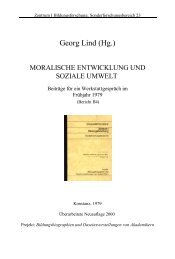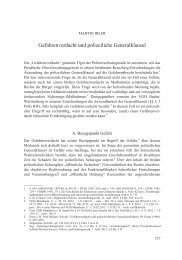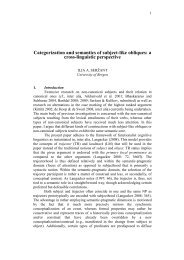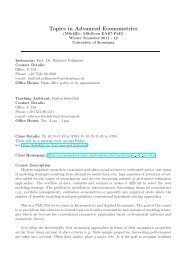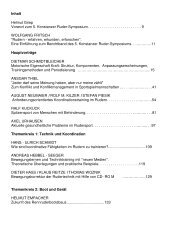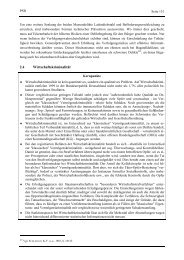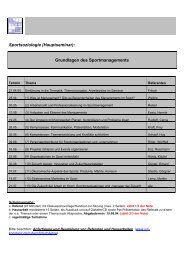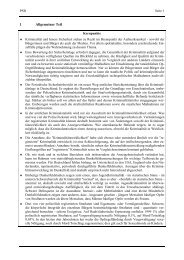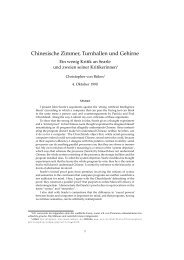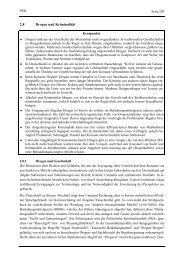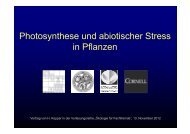Book of Abstracts Book of Abstracts - Universität Konstanz
Book of Abstracts Book of Abstracts - Universität Konstanz
Book of Abstracts Book of Abstracts - Universität Konstanz
You also want an ePaper? Increase the reach of your titles
YUMPU automatically turns print PDFs into web optimized ePapers that Google loves.
B - 34<br />
Relaxation Dynamics <strong>of</strong> Optically Excited States <strong>of</strong> Ag Cluster Anions<br />
74<br />
Markus Engelke, Marco Niemietz, Young Dok Kim, Gerd Ganteför<br />
Fachbereich Physik, <strong>Universität</strong> <strong>Konstanz</strong>, 78457 <strong>Konstanz</strong>, Germany<br />
http://www.clusterphysik.uni-konstanz.de/<br />
For bulk metals, optically excited electronic states can relax within few tens <strong>of</strong><br />
femtoseconds due to very fast Auger-like electron-electron scattering processes. As the size <strong>of</strong> a<br />
particle decreases, changes in relaxation dynamics <strong>of</strong> optically excited states are observed [1,2].<br />
Using Time-Resolved Two-Photon Photoemission (TR-PPE) spectroscopy, relaxation times <strong>of</strong><br />
optically excited states <strong>of</strong> Ag cluster anions consisting <strong>of</strong> less than 22 atoms (pump photon<br />
energy <strong>of</strong> 1.5 eV) were determined. For Ag18 - , Ag19 - and Ag21 - , relaxation times amount to about<br />
500 femtoseconds, which are significantly longer than those <strong>of</strong> d-metal clusters consisting <strong>of</strong><br />
less than 8 atoms [3]. The long life times <strong>of</strong> the excited states <strong>of</strong> these Ag cluster anions can be<br />
explained by lower density <strong>of</strong> states above the upper levels <strong>of</strong> the non-excited electrons within<br />
the pump photon energy in these clusters, caused by a large gap between 2s and 1f electronic<br />
shells, i.e. electronic shell configurations significantly affect the electron relaxation dynamics.<br />
-<br />
Ag18 Intensity (a.u.)<br />
References<br />
0 fs<br />
133 fs<br />
266 fs<br />
932 fs<br />
1,9 ps<br />
12,9 ps<br />
48,6 ps<br />
0 1 2<br />
Binding Energy (eV)<br />
Figure 1. TR-PPE spectra <strong>of</strong> Ag 18 - . A distinct peak can<br />
be observed at a binding energy <strong>of</strong> about 1.3 eV,<br />
accompanying broad states at higher binding energies.<br />
The state at 1.3 eV can be attributed to the excitation <strong>of</strong><br />
an electron in the HOMO to an unoccupied state. As the<br />
delay between pump and probe photons increases, the<br />
signals between 1.2eV - 2.5 eV attenuate. By assuming<br />
an exponential decay <strong>of</strong> the excited state, the lifetime is<br />
estimated to be about 420 fs.<br />
[1] J.R.R. Verlet, A.E. Bragg, A. Kammrath, O. Cheshnovsky, and D.M. Neumark,<br />
J. Chem. Phys. 121, 10015 (2004).<br />
[2] M. Niemietz, P. Gerhardt, G. Ganteför and Y. D. Kim, Chem. Phys. Lett. 380, 99 (2003).<br />
[3] N. Pontius, M. Neeb, W. Eberhardt, G. Lüttgens, P. S. Bechthold, Phys. Rev. B 67, 354251 (2003)<br />
and references therein



